Danish Employment Relations: A Critique
VerifiedAdded on 2020/03/04
|13
|3691
|54
Essay
AI Summary
This assignment asks for a critical analysis of Danish employment relations. It requires you to examine the history, core characteristics, and contemporary issues facing this system. You'll delve into concepts like social pacts, flexicurity, centralized bargaining, and the role of unions and mediation institutions. The focus is on evaluating the strengths and weaknesses of the Danish model in a changing global context.
Contribute Materials
Your contribution can guide someone’s learning journey. Share your
documents today.
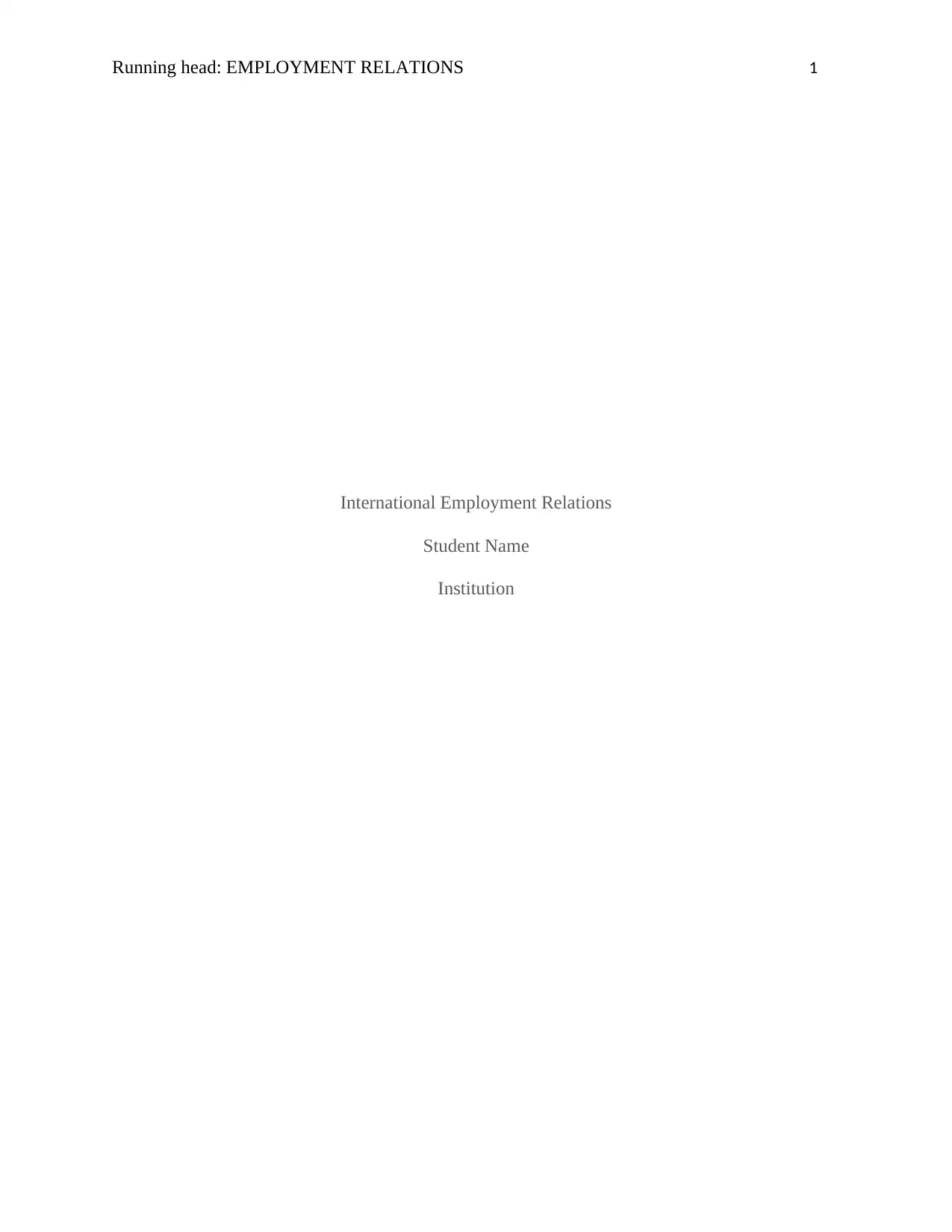
Running head: EMPLOYMENT RELATIONS 1
International Employment Relations
Student Name
Institution
International Employment Relations
Student Name
Institution
Secure Best Marks with AI Grader
Need help grading? Try our AI Grader for instant feedback on your assignments.
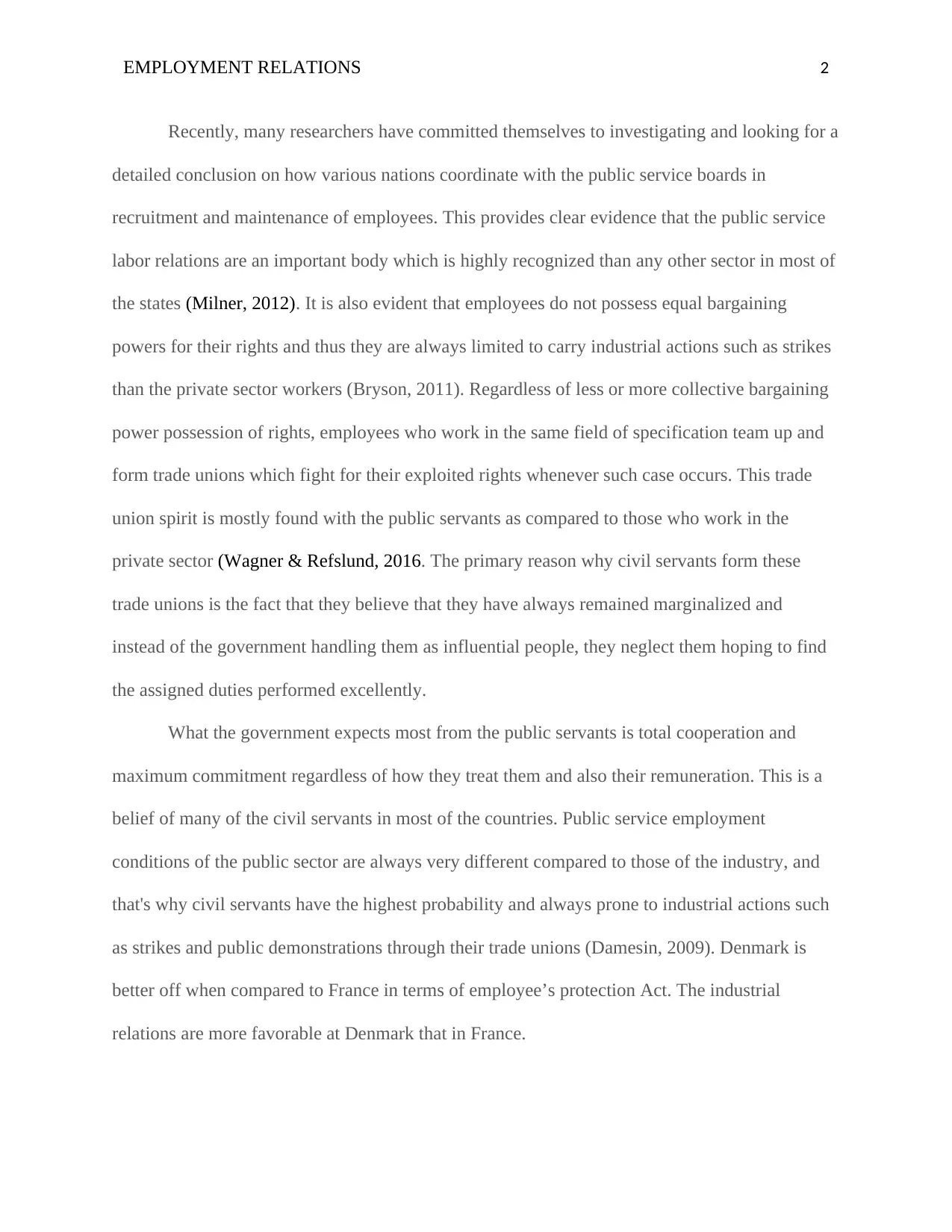
EMPLOYMENT RELATIONS 2
Recently, many researchers have committed themselves to investigating and looking for a
detailed conclusion on how various nations coordinate with the public service boards in
recruitment and maintenance of employees. This provides clear evidence that the public service
labor relations are an important body which is highly recognized than any other sector in most of
the states (Milner, 2012). It is also evident that employees do not possess equal bargaining
powers for their rights and thus they are always limited to carry industrial actions such as strikes
than the private sector workers (Bryson, 2011). Regardless of less or more collective bargaining
power possession of rights, employees who work in the same field of specification team up and
form trade unions which fight for their exploited rights whenever such case occurs. This trade
union spirit is mostly found with the public servants as compared to those who work in the
private sector (Wagner & Refslund, 2016. The primary reason why civil servants form these
trade unions is the fact that they believe that they have always remained marginalized and
instead of the government handling them as influential people, they neglect them hoping to find
the assigned duties performed excellently.
What the government expects most from the public servants is total cooperation and
maximum commitment regardless of how they treat them and also their remuneration. This is a
belief of many of the civil servants in most of the countries. Public service employment
conditions of the public sector are always very different compared to those of the industry, and
that's why civil servants have the highest probability and always prone to industrial actions such
as strikes and public demonstrations through their trade unions (Damesin, 2009). Denmark is
better off when compared to France in terms of employee’s protection Act. The industrial
relations are more favorable at Denmark that in France.
Recently, many researchers have committed themselves to investigating and looking for a
detailed conclusion on how various nations coordinate with the public service boards in
recruitment and maintenance of employees. This provides clear evidence that the public service
labor relations are an important body which is highly recognized than any other sector in most of
the states (Milner, 2012). It is also evident that employees do not possess equal bargaining
powers for their rights and thus they are always limited to carry industrial actions such as strikes
than the private sector workers (Bryson, 2011). Regardless of less or more collective bargaining
power possession of rights, employees who work in the same field of specification team up and
form trade unions which fight for their exploited rights whenever such case occurs. This trade
union spirit is mostly found with the public servants as compared to those who work in the
private sector (Wagner & Refslund, 2016. The primary reason why civil servants form these
trade unions is the fact that they believe that they have always remained marginalized and
instead of the government handling them as influential people, they neglect them hoping to find
the assigned duties performed excellently.
What the government expects most from the public servants is total cooperation and
maximum commitment regardless of how they treat them and also their remuneration. This is a
belief of many of the civil servants in most of the countries. Public service employment
conditions of the public sector are always very different compared to those of the industry, and
that's why civil servants have the highest probability and always prone to industrial actions such
as strikes and public demonstrations through their trade unions (Damesin, 2009). Denmark is
better off when compared to France in terms of employee’s protection Act. The industrial
relations are more favorable at Denmark that in France.
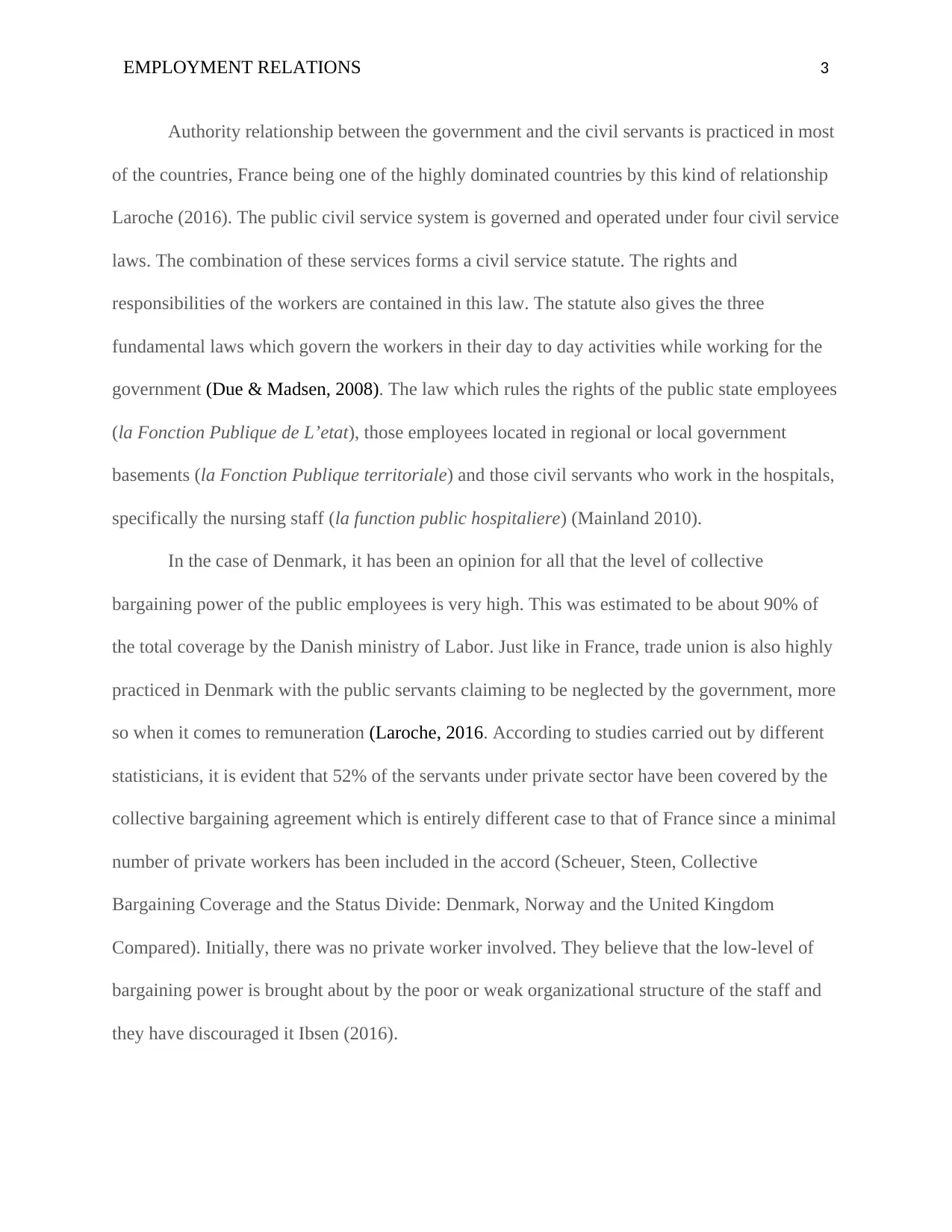
EMPLOYMENT RELATIONS 3
Authority relationship between the government and the civil servants is practiced in most
of the countries, France being one of the highly dominated countries by this kind of relationship
Laroche (2016). The public civil service system is governed and operated under four civil service
laws. The combination of these services forms a civil service statute. The rights and
responsibilities of the workers are contained in this law. The statute also gives the three
fundamental laws which govern the workers in their day to day activities while working for the
government (Due & Madsen, 2008). The law which rules the rights of the public state employees
(la Fonction Publique de L’etat), those employees located in regional or local government
basements (la Fonction Publique territoriale) and those civil servants who work in the hospitals,
specifically the nursing staff (la function public hospitaliere) (Mainland 2010).
In the case of Denmark, it has been an opinion for all that the level of collective
bargaining power of the public employees is very high. This was estimated to be about 90% of
the total coverage by the Danish ministry of Labor. Just like in France, trade union is also highly
practiced in Denmark with the public servants claiming to be neglected by the government, more
so when it comes to remuneration (Laroche, 2016. According to studies carried out by different
statisticians, it is evident that 52% of the servants under private sector have been covered by the
collective bargaining agreement which is entirely different case to that of France since a minimal
number of private workers has been included in the accord (Scheuer, Steen, Collective
Bargaining Coverage and the Status Divide: Denmark, Norway and the United Kingdom
Compared). Initially, there was no private worker involved. They believe that the low-level of
bargaining power is brought about by the poor or weak organizational structure of the staff and
they have discouraged it Ibsen (2016).
Authority relationship between the government and the civil servants is practiced in most
of the countries, France being one of the highly dominated countries by this kind of relationship
Laroche (2016). The public civil service system is governed and operated under four civil service
laws. The combination of these services forms a civil service statute. The rights and
responsibilities of the workers are contained in this law. The statute also gives the three
fundamental laws which govern the workers in their day to day activities while working for the
government (Due & Madsen, 2008). The law which rules the rights of the public state employees
(la Fonction Publique de L’etat), those employees located in regional or local government
basements (la Fonction Publique territoriale) and those civil servants who work in the hospitals,
specifically the nursing staff (la function public hospitaliere) (Mainland 2010).
In the case of Denmark, it has been an opinion for all that the level of collective
bargaining power of the public employees is very high. This was estimated to be about 90% of
the total coverage by the Danish ministry of Labor. Just like in France, trade union is also highly
practiced in Denmark with the public servants claiming to be neglected by the government, more
so when it comes to remuneration (Laroche, 2016. According to studies carried out by different
statisticians, it is evident that 52% of the servants under private sector have been covered by the
collective bargaining agreement which is entirely different case to that of France since a minimal
number of private workers has been included in the accord (Scheuer, Steen, Collective
Bargaining Coverage and the Status Divide: Denmark, Norway and the United Kingdom
Compared). Initially, there was no private worker involved. They believe that the low-level of
bargaining power is brought about by the poor or weak organizational structure of the staff and
they have discouraged it Ibsen (2016).
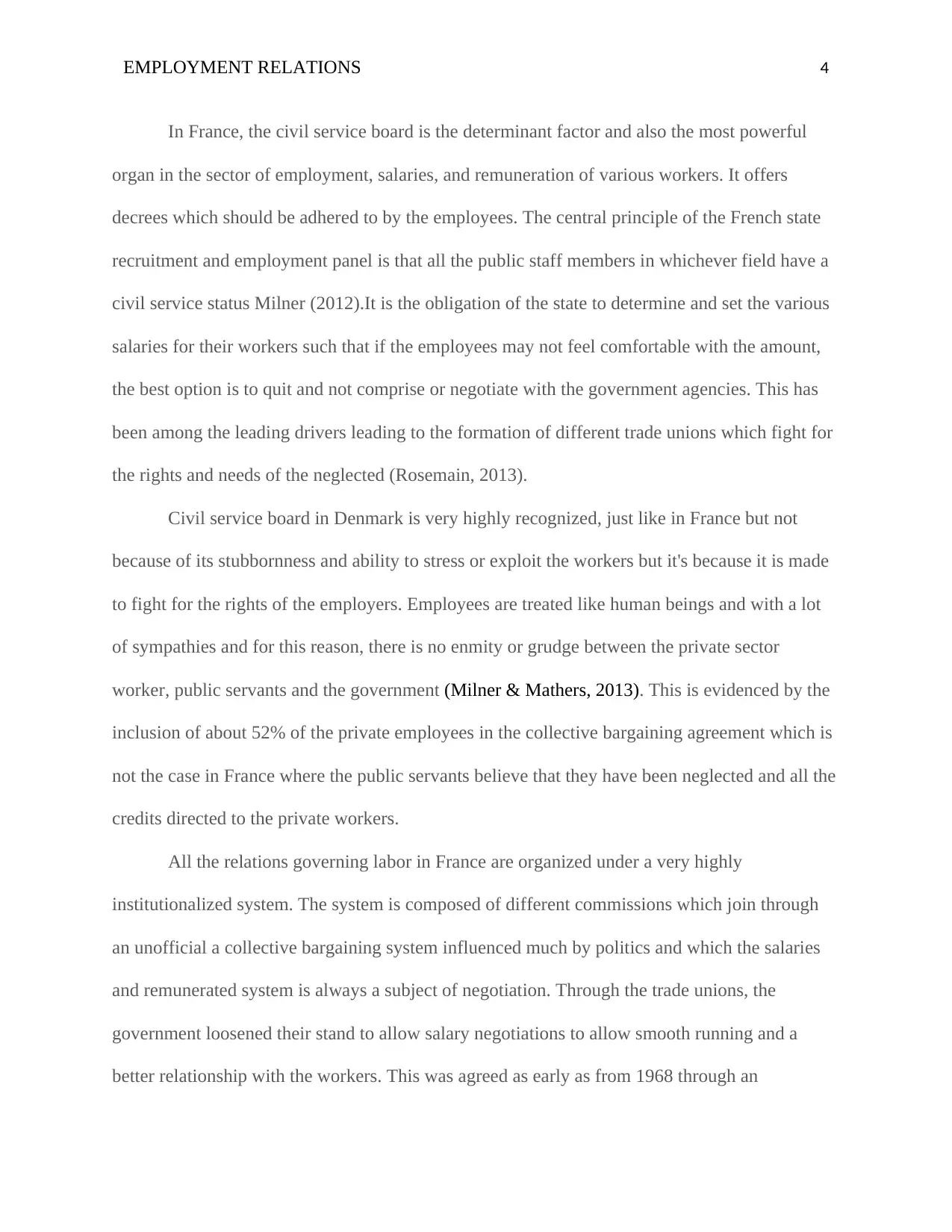
EMPLOYMENT RELATIONS 4
In France, the civil service board is the determinant factor and also the most powerful
organ in the sector of employment, salaries, and remuneration of various workers. It offers
decrees which should be adhered to by the employees. The central principle of the French state
recruitment and employment panel is that all the public staff members in whichever field have a
civil service status Milner (2012).It is the obligation of the state to determine and set the various
salaries for their workers such that if the employees may not feel comfortable with the amount,
the best option is to quit and not comprise or negotiate with the government agencies. This has
been among the leading drivers leading to the formation of different trade unions which fight for
the rights and needs of the neglected (Rosemain, 2013).
Civil service board in Denmark is very highly recognized, just like in France but not
because of its stubbornness and ability to stress or exploit the workers but it's because it is made
to fight for the rights of the employers. Employees are treated like human beings and with a lot
of sympathies and for this reason, there is no enmity or grudge between the private sector
worker, public servants and the government (Milner & Mathers, 2013). This is evidenced by the
inclusion of about 52% of the private employees in the collective bargaining agreement which is
not the case in France where the public servants believe that they have been neglected and all the
credits directed to the private workers.
All the relations governing labor in France are organized under a very highly
institutionalized system. The system is composed of different commissions which join through
an unofficial a collective bargaining system influenced much by politics and which the salaries
and remunerated system is always a subject of negotiation. Through the trade unions, the
government loosened their stand to allow salary negotiations to allow smooth running and a
better relationship with the workers. This was agreed as early as from 1968 through an
In France, the civil service board is the determinant factor and also the most powerful
organ in the sector of employment, salaries, and remuneration of various workers. It offers
decrees which should be adhered to by the employees. The central principle of the French state
recruitment and employment panel is that all the public staff members in whichever field have a
civil service status Milner (2012).It is the obligation of the state to determine and set the various
salaries for their workers such that if the employees may not feel comfortable with the amount,
the best option is to quit and not comprise or negotiate with the government agencies. This has
been among the leading drivers leading to the formation of different trade unions which fight for
the rights and needs of the neglected (Rosemain, 2013).
Civil service board in Denmark is very highly recognized, just like in France but not
because of its stubbornness and ability to stress or exploit the workers but it's because it is made
to fight for the rights of the employers. Employees are treated like human beings and with a lot
of sympathies and for this reason, there is no enmity or grudge between the private sector
worker, public servants and the government (Milner & Mathers, 2013). This is evidenced by the
inclusion of about 52% of the private employees in the collective bargaining agreement which is
not the case in France where the public servants believe that they have been neglected and all the
credits directed to the private workers.
All the relations governing labor in France are organized under a very highly
institutionalized system. The system is composed of different commissions which join through
an unofficial a collective bargaining system influenced much by politics and which the salaries
and remunerated system is always a subject of negotiation. Through the trade unions, the
government loosened their stand to allow salary negotiations to allow smooth running and a
better relationship with the workers. This was agreed as early as from 1968 through an
Secure Best Marks with AI Grader
Need help grading? Try our AI Grader for instant feedback on your assignments.
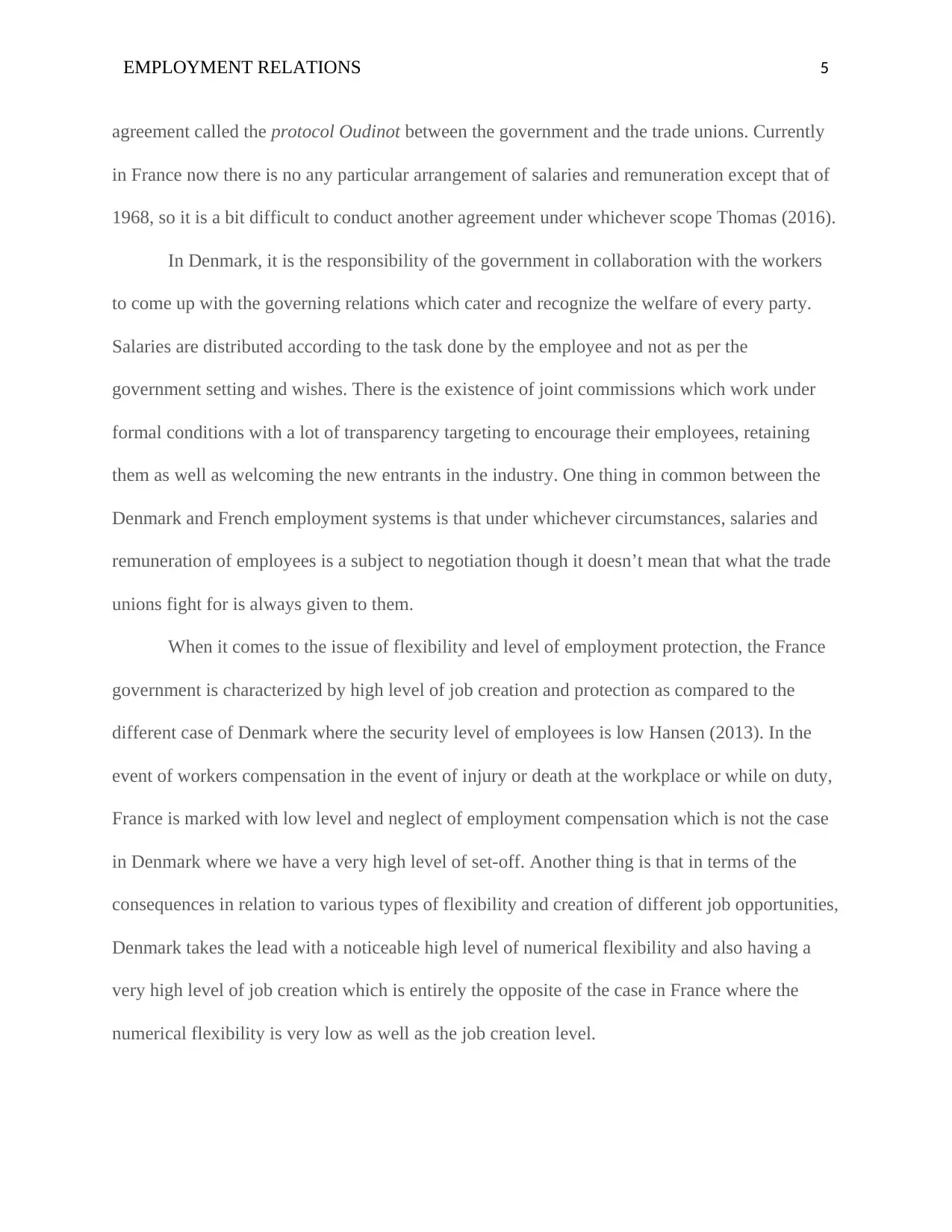
EMPLOYMENT RELATIONS 5
agreement called the protocol Oudinot between the government and the trade unions. Currently
in France now there is no any particular arrangement of salaries and remuneration except that of
1968, so it is a bit difficult to conduct another agreement under whichever scope Thomas (2016).
In Denmark, it is the responsibility of the government in collaboration with the workers
to come up with the governing relations which cater and recognize the welfare of every party.
Salaries are distributed according to the task done by the employee and not as per the
government setting and wishes. There is the existence of joint commissions which work under
formal conditions with a lot of transparency targeting to encourage their employees, retaining
them as well as welcoming the new entrants in the industry. One thing in common between the
Denmark and French employment systems is that under whichever circumstances, salaries and
remuneration of employees is a subject to negotiation though it doesn’t mean that what the trade
unions fight for is always given to them.
When it comes to the issue of flexibility and level of employment protection, the France
government is characterized by high level of job creation and protection as compared to the
different case of Denmark where the security level of employees is low Hansen (2013). In the
event of workers compensation in the event of injury or death at the workplace or while on duty,
France is marked with low level and neglect of employment compensation which is not the case
in Denmark where we have a very high level of set-off. Another thing is that in terms of the
consequences in relation to various types of flexibility and creation of different job opportunities,
Denmark takes the lead with a noticeable high level of numerical flexibility and also having a
very high level of job creation which is entirely the opposite of the case in France where the
numerical flexibility is very low as well as the job creation level.
agreement called the protocol Oudinot between the government and the trade unions. Currently
in France now there is no any particular arrangement of salaries and remuneration except that of
1968, so it is a bit difficult to conduct another agreement under whichever scope Thomas (2016).
In Denmark, it is the responsibility of the government in collaboration with the workers
to come up with the governing relations which cater and recognize the welfare of every party.
Salaries are distributed according to the task done by the employee and not as per the
government setting and wishes. There is the existence of joint commissions which work under
formal conditions with a lot of transparency targeting to encourage their employees, retaining
them as well as welcoming the new entrants in the industry. One thing in common between the
Denmark and French employment systems is that under whichever circumstances, salaries and
remuneration of employees is a subject to negotiation though it doesn’t mean that what the trade
unions fight for is always given to them.
When it comes to the issue of flexibility and level of employment protection, the France
government is characterized by high level of job creation and protection as compared to the
different case of Denmark where the security level of employees is low Hansen (2013). In the
event of workers compensation in the event of injury or death at the workplace or while on duty,
France is marked with low level and neglect of employment compensation which is not the case
in Denmark where we have a very high level of set-off. Another thing is that in terms of the
consequences in relation to various types of flexibility and creation of different job opportunities,
Denmark takes the lead with a noticeable high level of numerical flexibility and also having a
very high level of job creation which is entirely the opposite of the case in France where the
numerical flexibility is very low as well as the job creation level.
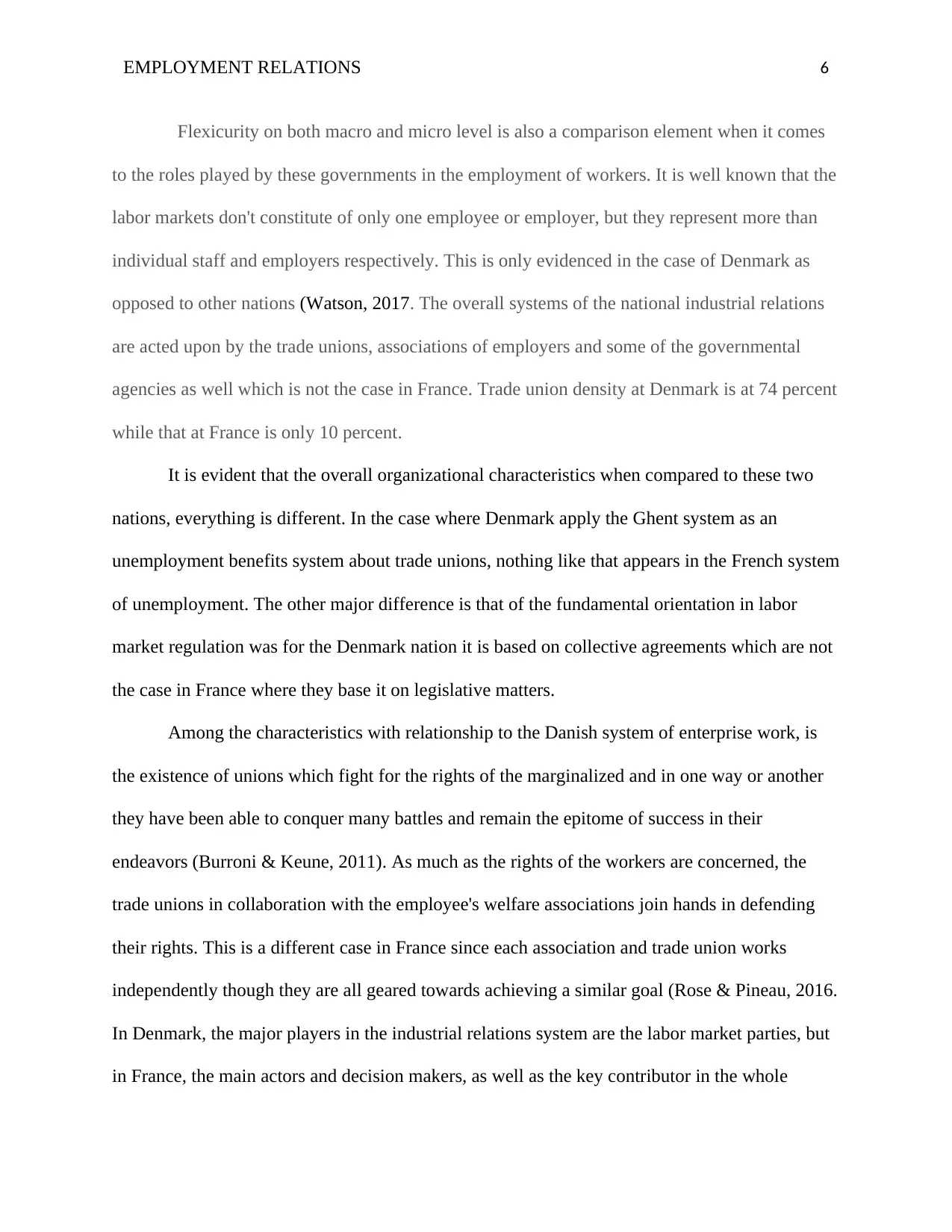
EMPLOYMENT RELATIONS 6
Flexicurity on both macro and micro level is also a comparison element when it comes
to the roles played by these governments in the employment of workers. It is well known that the
labor markets don't constitute of only one employee or employer, but they represent more than
individual staff and employers respectively. This is only evidenced in the case of Denmark as
opposed to other nations (Watson, 2017. The overall systems of the national industrial relations
are acted upon by the trade unions, associations of employers and some of the governmental
agencies as well which is not the case in France. Trade union density at Denmark is at 74 percent
while that at France is only 10 percent.
It is evident that the overall organizational characteristics when compared to these two
nations, everything is different. In the case where Denmark apply the Ghent system as an
unemployment benefits system about trade unions, nothing like that appears in the French system
of unemployment. The other major difference is that of the fundamental orientation in labor
market regulation was for the Denmark nation it is based on collective agreements which are not
the case in France where they base it on legislative matters.
Among the characteristics with relationship to the Danish system of enterprise work, is
the existence of unions which fight for the rights of the marginalized and in one way or another
they have been able to conquer many battles and remain the epitome of success in their
endeavors (Burroni & Keune, 2011). As much as the rights of the workers are concerned, the
trade unions in collaboration with the employee's welfare associations join hands in defending
their rights. This is a different case in France since each association and trade union works
independently though they are all geared towards achieving a similar goal (Rose & Pineau, 2016.
In Denmark, the major players in the industrial relations system are the labor market parties, but
in France, the main actors and decision makers, as well as the key contributor in the whole
Flexicurity on both macro and micro level is also a comparison element when it comes
to the roles played by these governments in the employment of workers. It is well known that the
labor markets don't constitute of only one employee or employer, but they represent more than
individual staff and employers respectively. This is only evidenced in the case of Denmark as
opposed to other nations (Watson, 2017. The overall systems of the national industrial relations
are acted upon by the trade unions, associations of employers and some of the governmental
agencies as well which is not the case in France. Trade union density at Denmark is at 74 percent
while that at France is only 10 percent.
It is evident that the overall organizational characteristics when compared to these two
nations, everything is different. In the case where Denmark apply the Ghent system as an
unemployment benefits system about trade unions, nothing like that appears in the French system
of unemployment. The other major difference is that of the fundamental orientation in labor
market regulation was for the Denmark nation it is based on collective agreements which are not
the case in France where they base it on legislative matters.
Among the characteristics with relationship to the Danish system of enterprise work, is
the existence of unions which fight for the rights of the marginalized and in one way or another
they have been able to conquer many battles and remain the epitome of success in their
endeavors (Burroni & Keune, 2011). As much as the rights of the workers are concerned, the
trade unions in collaboration with the employee's welfare associations join hands in defending
their rights. This is a different case in France since each association and trade union works
independently though they are all geared towards achieving a similar goal (Rose & Pineau, 2016.
In Denmark, the major players in the industrial relations system are the labor market parties, but
in France, the main actors and decision makers, as well as the key contributor in the whole
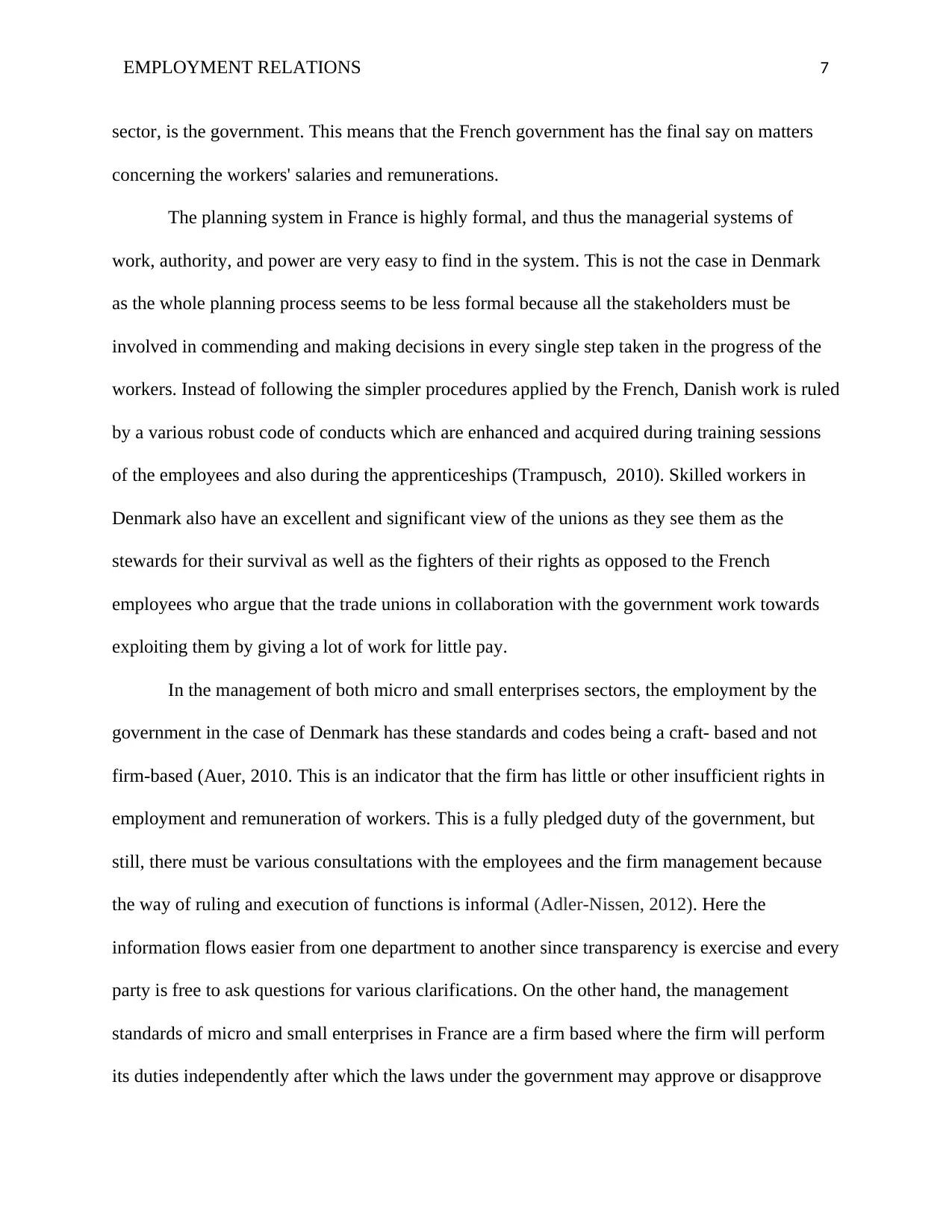
EMPLOYMENT RELATIONS 7
sector, is the government. This means that the French government has the final say on matters
concerning the workers' salaries and remunerations.
The planning system in France is highly formal, and thus the managerial systems of
work, authority, and power are very easy to find in the system. This is not the case in Denmark
as the whole planning process seems to be less formal because all the stakeholders must be
involved in commending and making decisions in every single step taken in the progress of the
workers. Instead of following the simpler procedures applied by the French, Danish work is ruled
by a various robust code of conducts which are enhanced and acquired during training sessions
of the employees and also during the apprenticeships (Trampusch, 2010). Skilled workers in
Denmark also have an excellent and significant view of the unions as they see them as the
stewards for their survival as well as the fighters of their rights as opposed to the French
employees who argue that the trade unions in collaboration with the government work towards
exploiting them by giving a lot of work for little pay.
In the management of both micro and small enterprises sectors, the employment by the
government in the case of Denmark has these standards and codes being a craft- based and not
firm-based (Auer, 2010. This is an indicator that the firm has little or other insufficient rights in
employment and remuneration of workers. This is a fully pledged duty of the government, but
still, there must be various consultations with the employees and the firm management because
the way of ruling and execution of functions is informal (Adler-Nissen, 2012). Here the
information flows easier from one department to another since transparency is exercise and every
party is free to ask questions for various clarifications. On the other hand, the management
standards of micro and small enterprises in France are a firm based where the firm will perform
its duties independently after which the laws under the government may approve or disapprove
sector, is the government. This means that the French government has the final say on matters
concerning the workers' salaries and remunerations.
The planning system in France is highly formal, and thus the managerial systems of
work, authority, and power are very easy to find in the system. This is not the case in Denmark
as the whole planning process seems to be less formal because all the stakeholders must be
involved in commending and making decisions in every single step taken in the progress of the
workers. Instead of following the simpler procedures applied by the French, Danish work is ruled
by a various robust code of conducts which are enhanced and acquired during training sessions
of the employees and also during the apprenticeships (Trampusch, 2010). Skilled workers in
Denmark also have an excellent and significant view of the unions as they see them as the
stewards for their survival as well as the fighters of their rights as opposed to the French
employees who argue that the trade unions in collaboration with the government work towards
exploiting them by giving a lot of work for little pay.
In the management of both micro and small enterprises sectors, the employment by the
government in the case of Denmark has these standards and codes being a craft- based and not
firm-based (Auer, 2010. This is an indicator that the firm has little or other insufficient rights in
employment and remuneration of workers. This is a fully pledged duty of the government, but
still, there must be various consultations with the employees and the firm management because
the way of ruling and execution of functions is informal (Adler-Nissen, 2012). Here the
information flows easier from one department to another since transparency is exercise and every
party is free to ask questions for various clarifications. On the other hand, the management
standards of micro and small enterprises in France are a firm based where the firm will perform
its duties independently after which the laws under the government may approve or disapprove
Paraphrase This Document
Need a fresh take? Get an instant paraphrase of this document with our AI Paraphraser
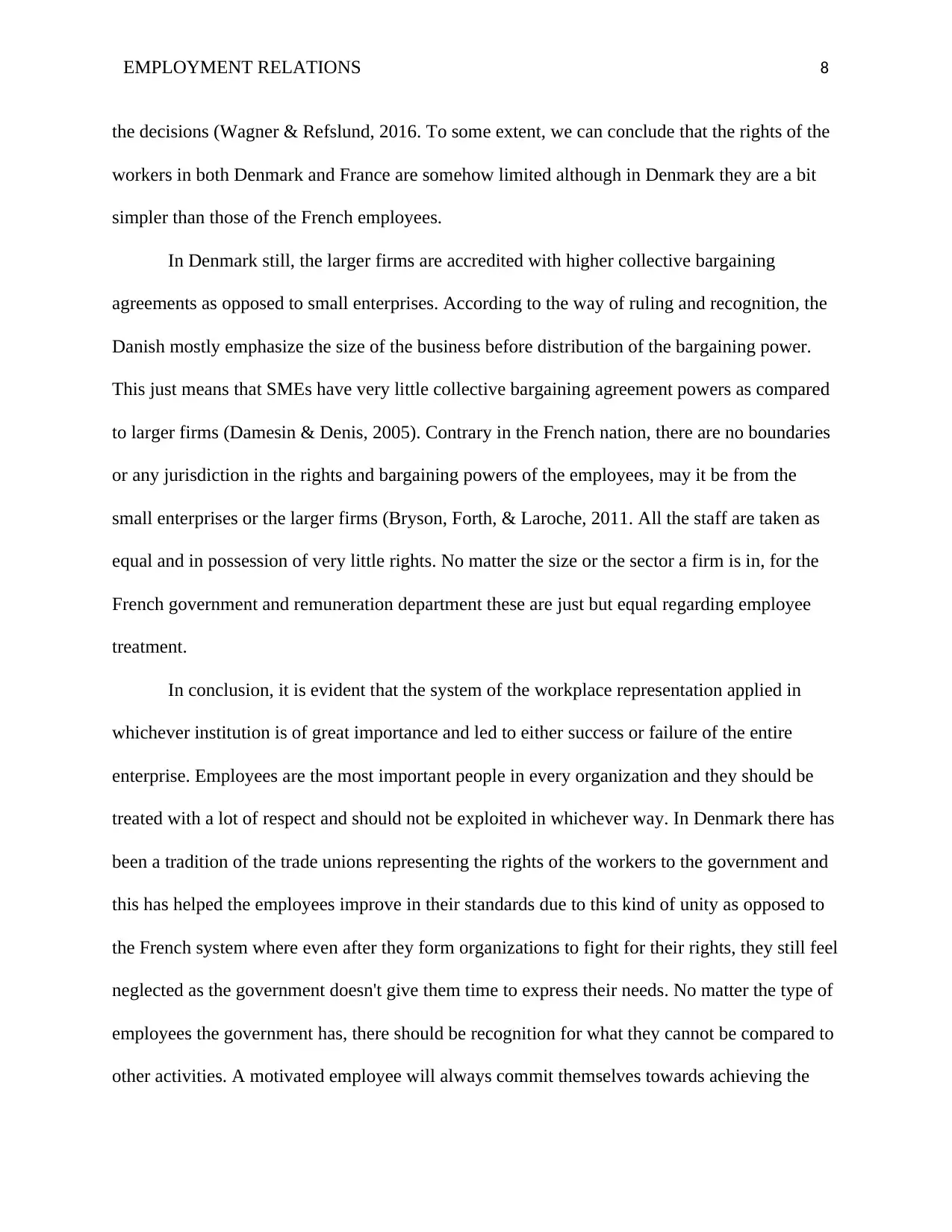
EMPLOYMENT RELATIONS 8
the decisions (Wagner & Refslund, 2016. To some extent, we can conclude that the rights of the
workers in both Denmark and France are somehow limited although in Denmark they are a bit
simpler than those of the French employees.
In Denmark still, the larger firms are accredited with higher collective bargaining
agreements as opposed to small enterprises. According to the way of ruling and recognition, the
Danish mostly emphasize the size of the business before distribution of the bargaining power.
This just means that SMEs have very little collective bargaining agreement powers as compared
to larger firms (Damesin & Denis, 2005). Contrary in the French nation, there are no boundaries
or any jurisdiction in the rights and bargaining powers of the employees, may it be from the
small enterprises or the larger firms (Bryson, Forth, & Laroche, 2011. All the staff are taken as
equal and in possession of very little rights. No matter the size or the sector a firm is in, for the
French government and remuneration department these are just but equal regarding employee
treatment.
In conclusion, it is evident that the system of the workplace representation applied in
whichever institution is of great importance and led to either success or failure of the entire
enterprise. Employees are the most important people in every organization and they should be
treated with a lot of respect and should not be exploited in whichever way. In Denmark there has
been a tradition of the trade unions representing the rights of the workers to the government and
this has helped the employees improve in their standards due to this kind of unity as opposed to
the French system where even after they form organizations to fight for their rights, they still feel
neglected as the government doesn't give them time to express their needs. No matter the type of
employees the government has, there should be recognition for what they cannot be compared to
other activities. A motivated employee will always commit themselves towards achieving the
the decisions (Wagner & Refslund, 2016. To some extent, we can conclude that the rights of the
workers in both Denmark and France are somehow limited although in Denmark they are a bit
simpler than those of the French employees.
In Denmark still, the larger firms are accredited with higher collective bargaining
agreements as opposed to small enterprises. According to the way of ruling and recognition, the
Danish mostly emphasize the size of the business before distribution of the bargaining power.
This just means that SMEs have very little collective bargaining agreement powers as compared
to larger firms (Damesin & Denis, 2005). Contrary in the French nation, there are no boundaries
or any jurisdiction in the rights and bargaining powers of the employees, may it be from the
small enterprises or the larger firms (Bryson, Forth, & Laroche, 2011. All the staff are taken as
equal and in possession of very little rights. No matter the size or the sector a firm is in, for the
French government and remuneration department these are just but equal regarding employee
treatment.
In conclusion, it is evident that the system of the workplace representation applied in
whichever institution is of great importance and led to either success or failure of the entire
enterprise. Employees are the most important people in every organization and they should be
treated with a lot of respect and should not be exploited in whichever way. In Denmark there has
been a tradition of the trade unions representing the rights of the workers to the government and
this has helped the employees improve in their standards due to this kind of unity as opposed to
the French system where even after they form organizations to fight for their rights, they still feel
neglected as the government doesn't give them time to express their needs. No matter the type of
employees the government has, there should be recognition for what they cannot be compared to
other activities. A motivated employee will always commit themselves towards achieving the
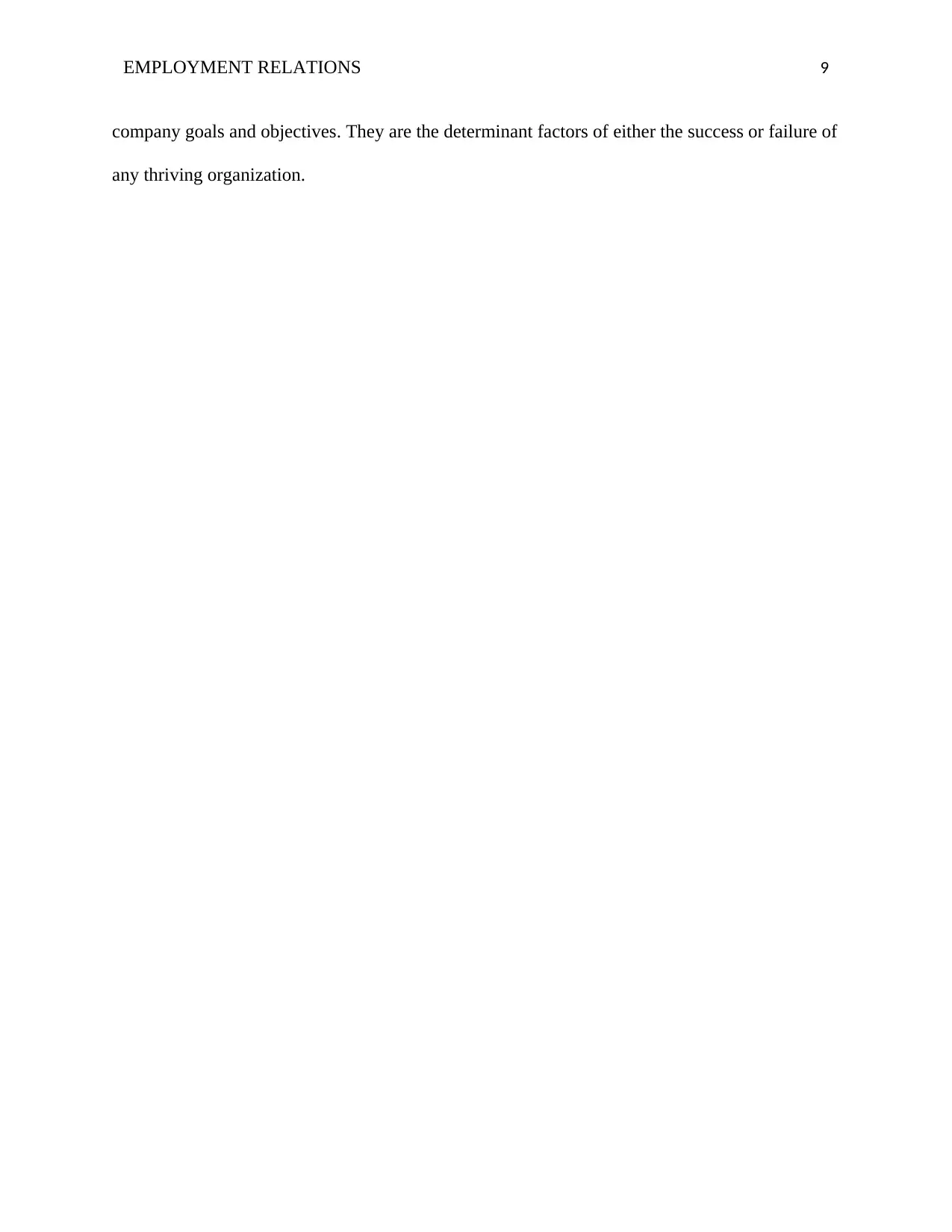
EMPLOYMENT RELATIONS 9
company goals and objectives. They are the determinant factors of either the success or failure of
any thriving organization.
company goals and objectives. They are the determinant factors of either the success or failure of
any thriving organization.
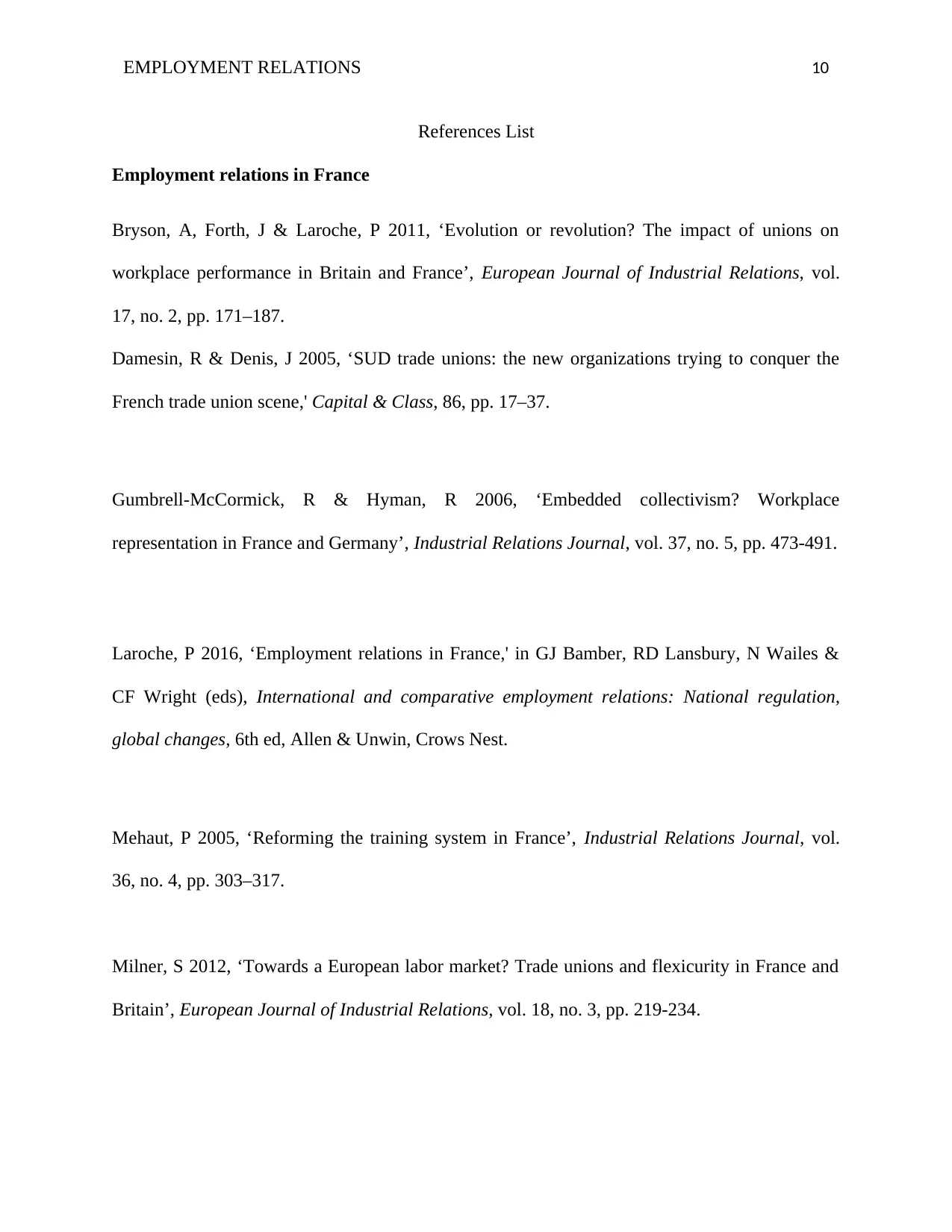
EMPLOYMENT RELATIONS 10
References List
Employment relations in France
Bryson, A, Forth, J & Laroche, P 2011, ‘Evolution or revolution? The impact of unions on
workplace performance in Britain and France’, European Journal of Industrial Relations, vol.
17, no. 2, pp. 171–187.
Damesin, R & Denis, J 2005, ‘SUD trade unions: the new organizations trying to conquer the
French trade union scene,' Capital & Class, 86, pp. 17–37.
Gumbrell-McCormick, R & Hyman, R 2006, ‘Embedded collectivism? Workplace
representation in France and Germany’, Industrial Relations Journal, vol. 37, no. 5, pp. 473-491.
Laroche, P 2016, ‘Employment relations in France,' in GJ Bamber, RD Lansbury, N Wailes &
CF Wright (eds), International and comparative employment relations: National regulation,
global changes, 6th ed, Allen & Unwin, Crows Nest.
Mehaut, P 2005, ‘Reforming the training system in France’, Industrial Relations Journal, vol.
36, no. 4, pp. 303–317.
Milner, S 2012, ‘Towards a European labor market? Trade unions and flexicurity in France and
Britain’, European Journal of Industrial Relations, vol. 18, no. 3, pp. 219-234.
References List
Employment relations in France
Bryson, A, Forth, J & Laroche, P 2011, ‘Evolution or revolution? The impact of unions on
workplace performance in Britain and France’, European Journal of Industrial Relations, vol.
17, no. 2, pp. 171–187.
Damesin, R & Denis, J 2005, ‘SUD trade unions: the new organizations trying to conquer the
French trade union scene,' Capital & Class, 86, pp. 17–37.
Gumbrell-McCormick, R & Hyman, R 2006, ‘Embedded collectivism? Workplace
representation in France and Germany’, Industrial Relations Journal, vol. 37, no. 5, pp. 473-491.
Laroche, P 2016, ‘Employment relations in France,' in GJ Bamber, RD Lansbury, N Wailes &
CF Wright (eds), International and comparative employment relations: National regulation,
global changes, 6th ed, Allen & Unwin, Crows Nest.
Mehaut, P 2005, ‘Reforming the training system in France’, Industrial Relations Journal, vol.
36, no. 4, pp. 303–317.
Milner, S 2012, ‘Towards a European labor market? Trade unions and flexicurity in France and
Britain’, European Journal of Industrial Relations, vol. 18, no. 3, pp. 219-234.
Secure Best Marks with AI Grader
Need help grading? Try our AI Grader for instant feedback on your assignments.
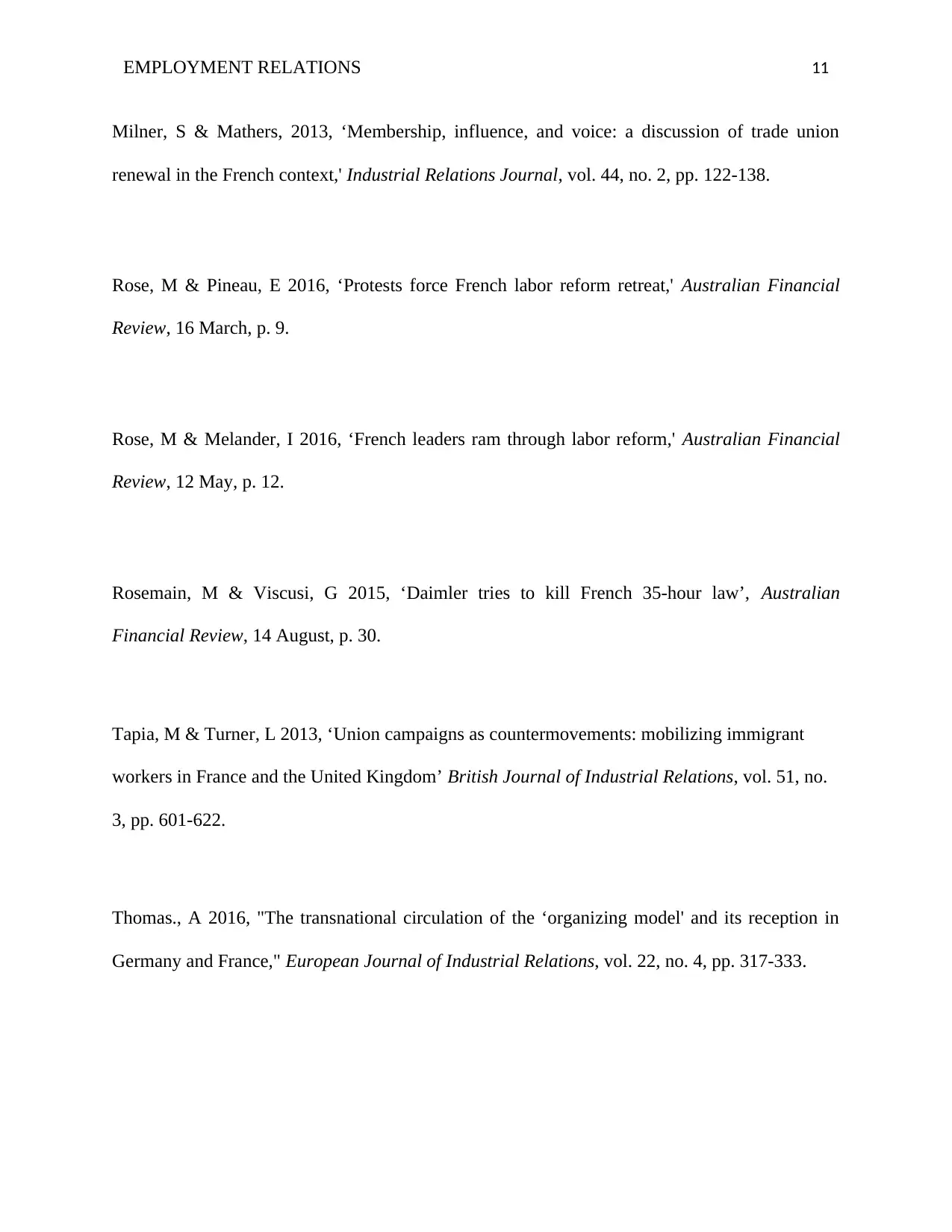
EMPLOYMENT RELATIONS 11
Milner, S & Mathers, 2013, ‘Membership, influence, and voice: a discussion of trade union
renewal in the French context,' Industrial Relations Journal, vol. 44, no. 2, pp. 122-138.
Rose, M & Pineau, E 2016, ‘Protests force French labor reform retreat,' Australian Financial
Review, 16 March, p. 9.
Rose, M & Melander, I 2016, ‘French leaders ram through labor reform,' Australian Financial
Review, 12 May, p. 12.
Rosemain, M & Viscusi, G 2015, ‘Daimler tries to kill French 35-hour law’, Australian
Financial Review, 14 August, p. 30.
Tapia, M & Turner, L 2013, ‘Union campaigns as countermovements: mobilizing immigrant
workers in France and the United Kingdom’ British Journal of Industrial Relations, vol. 51, no.
3, pp. 601-622.
Thomas., A 2016, "The transnational circulation of the ‘organizing model' and its reception in
Germany and France," European Journal of Industrial Relations, vol. 22, no. 4, pp. 317-333.
Milner, S & Mathers, 2013, ‘Membership, influence, and voice: a discussion of trade union
renewal in the French context,' Industrial Relations Journal, vol. 44, no. 2, pp. 122-138.
Rose, M & Pineau, E 2016, ‘Protests force French labor reform retreat,' Australian Financial
Review, 16 March, p. 9.
Rose, M & Melander, I 2016, ‘French leaders ram through labor reform,' Australian Financial
Review, 12 May, p. 12.
Rosemain, M & Viscusi, G 2015, ‘Daimler tries to kill French 35-hour law’, Australian
Financial Review, 14 August, p. 30.
Tapia, M & Turner, L 2013, ‘Union campaigns as countermovements: mobilizing immigrant
workers in France and the United Kingdom’ British Journal of Industrial Relations, vol. 51, no.
3, pp. 601-622.
Thomas., A 2016, "The transnational circulation of the ‘organizing model' and its reception in
Germany and France," European Journal of Industrial Relations, vol. 22, no. 4, pp. 317-333.
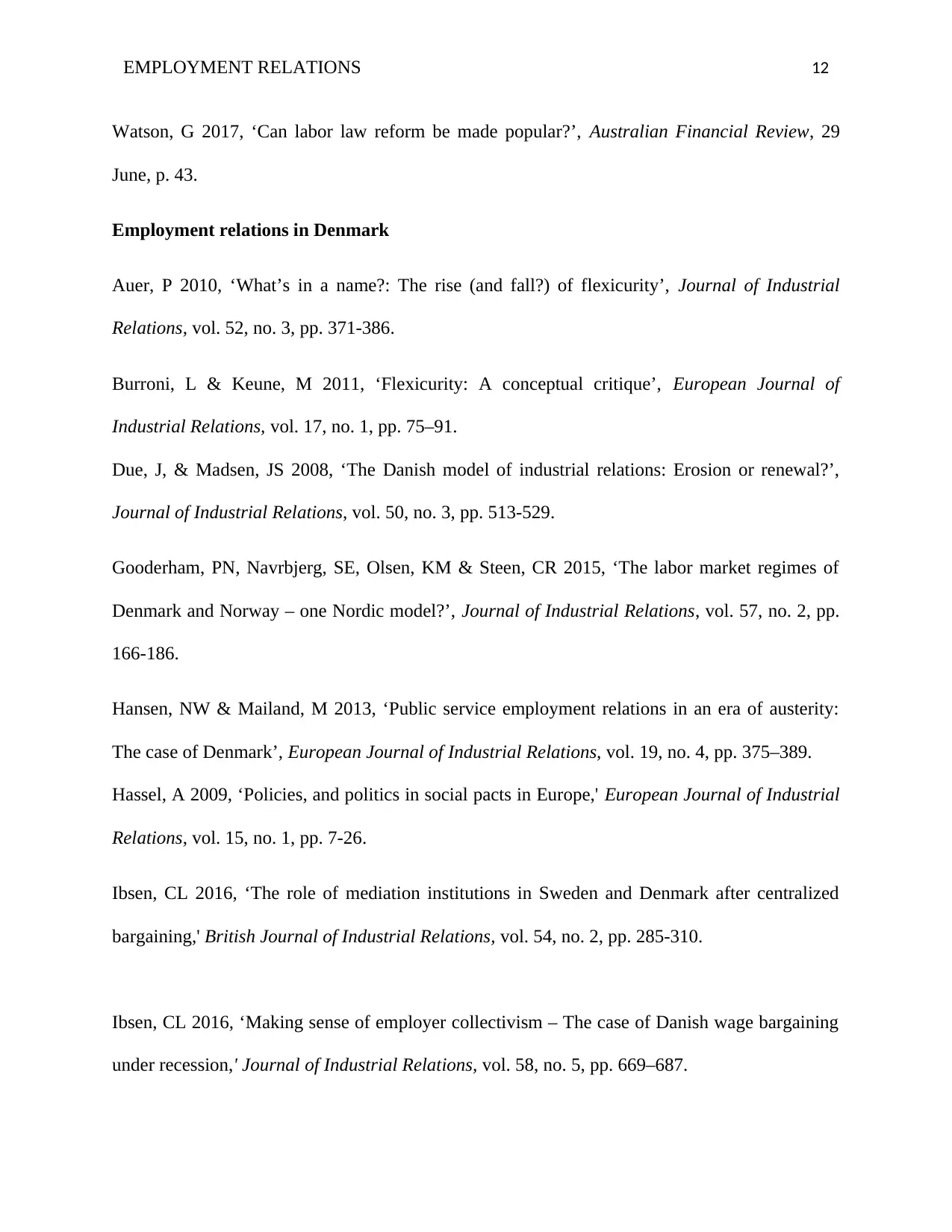
EMPLOYMENT RELATIONS 12
Watson, G 2017, ‘Can labor law reform be made popular?’, Australian Financial Review, 29
June, p. 43.
Employment relations in Denmark
Auer, P 2010, ‘What’s in a name?: The rise (and fall?) of flexicurity’, Journal of Industrial
Relations, vol. 52, no. 3, pp. 371-386.
Burroni, L & Keune, M 2011, ‘Flexicurity: A conceptual critique’, European Journal of
Industrial Relations, vol. 17, no. 1, pp. 75–91.
Due, J, & Madsen, JS 2008, ‘The Danish model of industrial relations: Erosion or renewal?’,
Journal of Industrial Relations, vol. 50, no. 3, pp. 513-529.
Gooderham, PN, Navrbjerg, SE, Olsen, KM & Steen, CR 2015, ‘The labor market regimes of
Denmark and Norway – one Nordic model?’, Journal of Industrial Relations, vol. 57, no. 2, pp.
166-186.
Hansen, NW & Mailand, M 2013, ‘Public service employment relations in an era of austerity:
The case of Denmark’, European Journal of Industrial Relations, vol. 19, no. 4, pp. 375–389.
Hassel, A 2009, ‘Policies, and politics in social pacts in Europe,' European Journal of Industrial
Relations, vol. 15, no. 1, pp. 7-26.
Ibsen, CL 2016, ‘The role of mediation institutions in Sweden and Denmark after centralized
bargaining,' British Journal of Industrial Relations, vol. 54, no. 2, pp. 285-310.
Ibsen, CL 2016, ‘Making sense of employer collectivism – The case of Danish wage bargaining
under recession,' Journal of Industrial Relations, vol. 58, no. 5, pp. 669–687.
Watson, G 2017, ‘Can labor law reform be made popular?’, Australian Financial Review, 29
June, p. 43.
Employment relations in Denmark
Auer, P 2010, ‘What’s in a name?: The rise (and fall?) of flexicurity’, Journal of Industrial
Relations, vol. 52, no. 3, pp. 371-386.
Burroni, L & Keune, M 2011, ‘Flexicurity: A conceptual critique’, European Journal of
Industrial Relations, vol. 17, no. 1, pp. 75–91.
Due, J, & Madsen, JS 2008, ‘The Danish model of industrial relations: Erosion or renewal?’,
Journal of Industrial Relations, vol. 50, no. 3, pp. 513-529.
Gooderham, PN, Navrbjerg, SE, Olsen, KM & Steen, CR 2015, ‘The labor market regimes of
Denmark and Norway – one Nordic model?’, Journal of Industrial Relations, vol. 57, no. 2, pp.
166-186.
Hansen, NW & Mailand, M 2013, ‘Public service employment relations in an era of austerity:
The case of Denmark’, European Journal of Industrial Relations, vol. 19, no. 4, pp. 375–389.
Hassel, A 2009, ‘Policies, and politics in social pacts in Europe,' European Journal of Industrial
Relations, vol. 15, no. 1, pp. 7-26.
Ibsen, CL 2016, ‘The role of mediation institutions in Sweden and Denmark after centralized
bargaining,' British Journal of Industrial Relations, vol. 54, no. 2, pp. 285-310.
Ibsen, CL 2016, ‘Making sense of employer collectivism – The case of Danish wage bargaining
under recession,' Journal of Industrial Relations, vol. 58, no. 5, pp. 669–687.
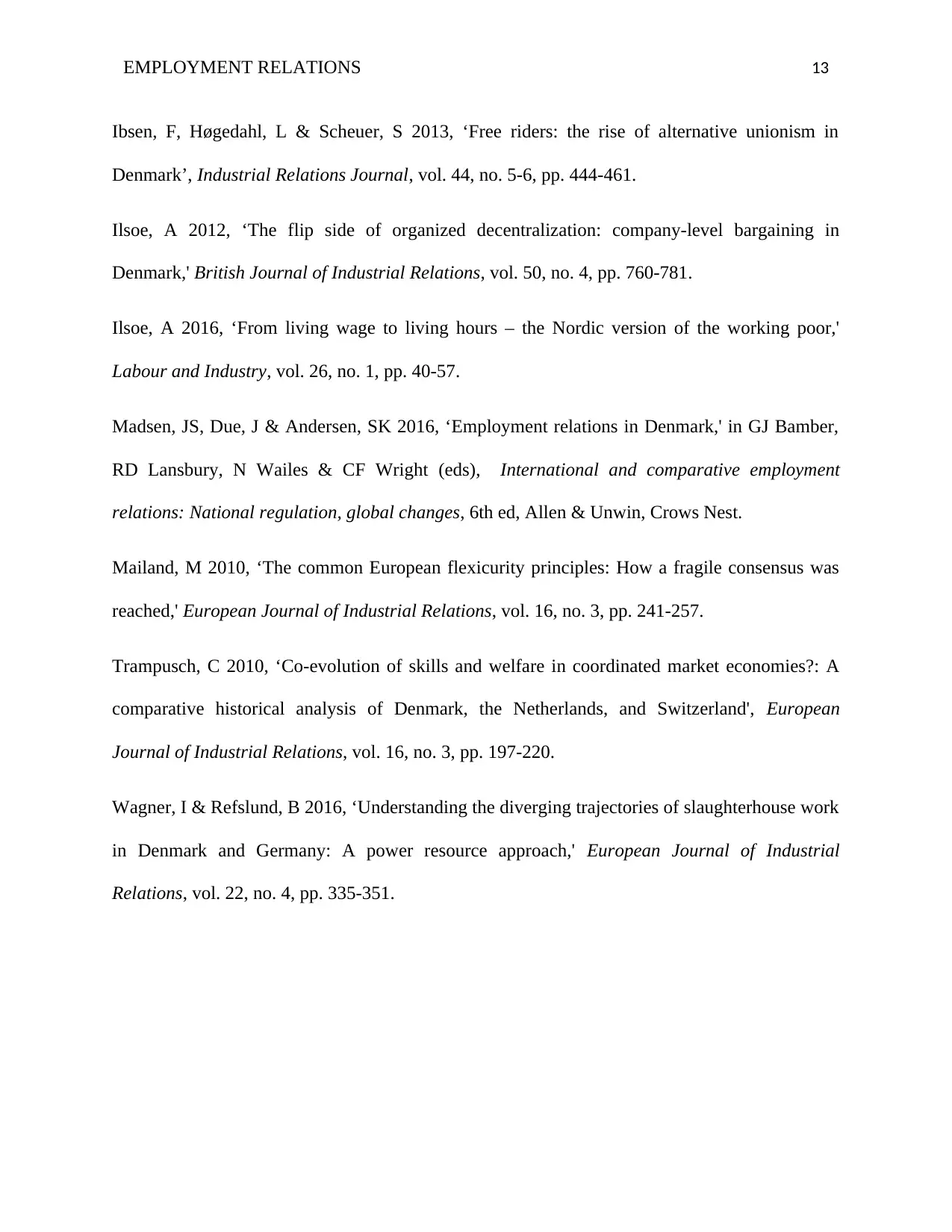
EMPLOYMENT RELATIONS 13
Ibsen, F, Høgedahl, L & Scheuer, S 2013, ‘Free riders: the rise of alternative unionism in
Denmark’, Industrial Relations Journal, vol. 44, no. 5-6, pp. 444-461.
Ilsoe, A 2012, ‘The flip side of organized decentralization: company-level bargaining in
Denmark,' British Journal of Industrial Relations, vol. 50, no. 4, pp. 760-781.
Ilsoe, A 2016, ‘From living wage to living hours – the Nordic version of the working poor,'
Labour and Industry, vol. 26, no. 1, pp. 40-57.
Madsen, JS, Due, J & Andersen, SK 2016, ‘Employment relations in Denmark,' in GJ Bamber,
RD Lansbury, N Wailes & CF Wright (eds), International and comparative employment
relations: National regulation, global changes, 6th ed, Allen & Unwin, Crows Nest.
Mailand, M 2010, ‘The common European flexicurity principles: How a fragile consensus was
reached,' European Journal of Industrial Relations, vol. 16, no. 3, pp. 241-257.
Trampusch, C 2010, ‘Co-evolution of skills and welfare in coordinated market economies?: A
comparative historical analysis of Denmark, the Netherlands, and Switzerland', European
Journal of Industrial Relations, vol. 16, no. 3, pp. 197-220.
Wagner, I & Refslund, B 2016, ‘Understanding the diverging trajectories of slaughterhouse work
in Denmark and Germany: A power resource approach,' European Journal of Industrial
Relations, vol. 22, no. 4, pp. 335-351.
Ibsen, F, Høgedahl, L & Scheuer, S 2013, ‘Free riders: the rise of alternative unionism in
Denmark’, Industrial Relations Journal, vol. 44, no. 5-6, pp. 444-461.
Ilsoe, A 2012, ‘The flip side of organized decentralization: company-level bargaining in
Denmark,' British Journal of Industrial Relations, vol. 50, no. 4, pp. 760-781.
Ilsoe, A 2016, ‘From living wage to living hours – the Nordic version of the working poor,'
Labour and Industry, vol. 26, no. 1, pp. 40-57.
Madsen, JS, Due, J & Andersen, SK 2016, ‘Employment relations in Denmark,' in GJ Bamber,
RD Lansbury, N Wailes & CF Wright (eds), International and comparative employment
relations: National regulation, global changes, 6th ed, Allen & Unwin, Crows Nest.
Mailand, M 2010, ‘The common European flexicurity principles: How a fragile consensus was
reached,' European Journal of Industrial Relations, vol. 16, no. 3, pp. 241-257.
Trampusch, C 2010, ‘Co-evolution of skills and welfare in coordinated market economies?: A
comparative historical analysis of Denmark, the Netherlands, and Switzerland', European
Journal of Industrial Relations, vol. 16, no. 3, pp. 197-220.
Wagner, I & Refslund, B 2016, ‘Understanding the diverging trajectories of slaughterhouse work
in Denmark and Germany: A power resource approach,' European Journal of Industrial
Relations, vol. 22, no. 4, pp. 335-351.
1 out of 13
Related Documents
Your All-in-One AI-Powered Toolkit for Academic Success.
+13062052269
info@desklib.com
Available 24*7 on WhatsApp / Email
![[object Object]](/_next/static/media/star-bottom.7253800d.svg)
Unlock your academic potential
© 2024 | Zucol Services PVT LTD | All rights reserved.





